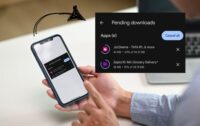The internet has been abuzz with the OpenAI and Moderna collaboration. However, little did anyone know that Healthify (formerly HealthifyMe), an Indian fitness and lifestyle startup, also uses OpenAI’s GPTs for real-time nutritional analysis and healthy suggestions, among other things.
OpenAI recognized Healthify during the release of GPT-4 Turbo when it used the model for real-time nutritional analysis. This was done through Snap 2.0, its image recognition feature, which led to a 50% increase in user engagement — indicative of better diet management and fitness wins.
According to OpenAI’s customer story, this new tool allows you to upload meal photos as they are and let Healthify do the rest. It combines in-house models with GPT-4 Vision to accurately understand user-specific contexts while keeping data privacy intact.
After image analysis, it uses custom heuristic models for accurate food recommendations, achieving human-like accuracy in dietary tracking.
Similarly, RIA — Healthify’s generative AI-powered virtual nutritionist and Coach Co-pilot — its coach-facing assistant now uses OpenAI’s GPT 3.5 and GPT-4 Turbo, respectively. Whisper – a machine-learning model for speech, is also deployed here.
This has doubled interactions with Ria. Now, users can engage in longer conversations and receive complex health insights, such as analyzing the impact of glucose levels on sleep, from various integrated data sources. Coaching responses supported by AI are twice as fast, leading to an 18% increase in client interaction.
The Khosla Ventures-backed startup used the Embeddings model by a San Francisco-based AI startup to solve a key challenge of accurately matching food names generated by GPT-4 with its internal database. This is because GPT-4 has different food name dictionaries from their system.
Under the Hood
In 2018, RIA was introduced as the world’s first AI-powered virtual nutritionist, marking a significant milestone in personalized health tech.
“Prior to adopting GPT models, RIA used hierarchical LSTM networks and custom NLU systems for interpreting and responding to user queries. As a predominantly rules-based system at first, RIA struggled with complex and less frequent queries, providing personalized feedback was challenging as platform scaled with user demands,” read the blog post.
Similarly, early versions of Snap were based on convolutional neural networks. They allowed users to take a photo of their meal, which the AI would analyze and log as caloric content tailored specifically for Indian cuisine.
Moreover, the system builds upon each interaction, gradually personalizing recommendations and improving accuracy based on individual dietary patterns and preferences.
But Snap had trouble recognizing foods in complicated dishes like salads or mixed Indian meals, thus resulting in inaccurate calorie count and nutritional assessments, undermining user trust and engagement. As Vashisht noted, this caused it to have a utilization rate of only 10-20% of the time.
A compact 30-member tech team drives Healthify’s success, closely collaborating with 15 analysts and data scientists, supported by seven product managers focused on AI-driven offerings. The company has over 700 health coaches serving about 240k clients globally.
“The team deploys multiple AI models, including generative and non-generative types, to enhance user interaction and data analysis,” said Tushar Vashisht, CEO of Healthify, while speaking with AIM.
He further added that they are also experimenting with statistical models from AWS, Meta, OpenAI, Anthropic, and Google, among others, in addition to open-source platforms that prioritize accuracy, reliability, and cost in their evaluations.
What Next for Healthify?
“Within the coming year we aim to make health apps more self-regulating and agent-like. They should not only give advice, but take necessary steps to promote healthcare,” said Abhijit Khasnis, vice president of technology at Healthify.
These bots will actively manage well-being by analyzing figures and suggesting the best diet, sleep and exercise. For example, based on data from trackers that monitor sleep patterns, physical activity levels and eating habits – machines might automatically book medical appointments or order specific nutritional foods for people with different health conditions.
According to the customer story, the Fitnein platform strung. It was glad to expand its services beyond national in its early days. It relied on traditional machine learning methods for growing in East Asia, which took which took two years. However, with Ope, nAI’s he, lp, they plan on going live in twenty countries by the close of the business this year as they work toward touching one billion lives worldwide.



